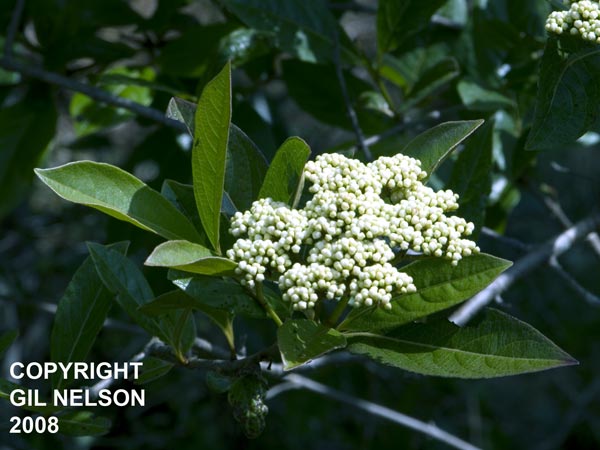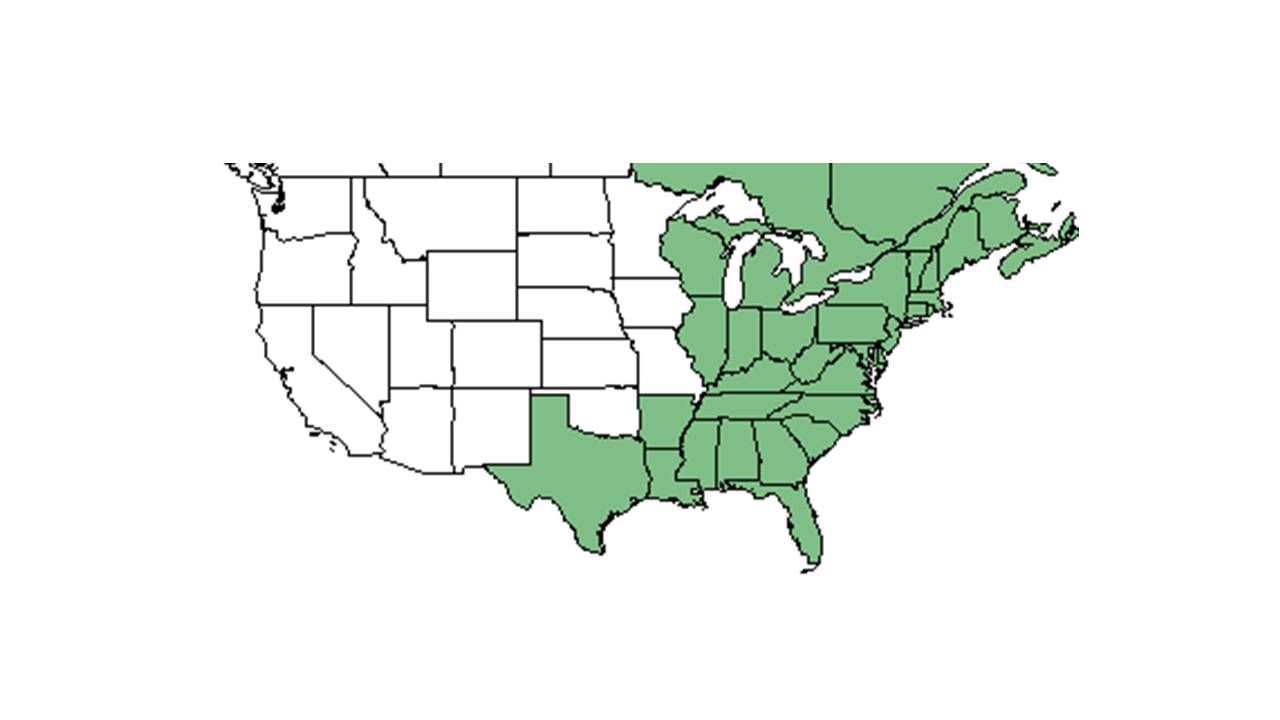Viburnum nudum
| Viburnum nudum | |
|---|---|

| |
| Photo taken by Gil Nelson | |
| Scientific classification | |
| Kingdom: | Plantae |
| Division: | Magnoliophyta – Flowering plants |
| Class: | Magnoliopsida – Dicotyledons |
| Order: | Dipsacales |
| Family: | Caprifoliaceae |
| Genus: | Viburnum |
| Species: | V. nudum |
| Binomial name | |
| Viburnum nudum L. | |

| |
| Natural range of Viburnum nudum from USDA NRCS Plants Database. | |
Common names: Possumhaw, Southern wild raisin
Contents
Taxonomic notes
Variations:Viburnum nudum var. angustifolium Torrey & A. Gray.[1]
Description
"Shrubs or less frequently small trees. Leaves simple, opposite, palmately lobed or toothed, rarely nearly entire; stipules absent, or present and adnate to the petioles. Cyme compound, flat-topped. Sepals 5, very small; corolla 5-lobed, rotate, white or pinkish, fertile flowers 5-8 mm broad; stamens 5. Sterile flowers, when present, usually zygomorphic, marginal and large. Drupe 1-seeded, usually laterally compressed."[2]
"Medium sized shrub. Similar to V. cassinoides. Leaves elliptic to elliptic-oblanceolate, 5-12 cm long, 2-6 cm wide, acute to acuminate, base cuneate to rarely rounded; petioles 0.5-2.5 cm long. Peduncles 1-4 cm long, rarely shorter, equaling or longer than the rays."[2]
Distribution
Viburnum nudum is widespread across the southeastern Coastal Plains region, with disjunct populations of V. nudum var. nudum in northwestern Virginia.[3]
Ecology
Habitat
In the Coastal Plain in Florida and Georgia, V. nudum can be found in mesic thickets, mesic woodlands, along spring-fed lakes, swampy woodlands, creek heads, ravine seepage areas, stagnant branch swamps, bottomland hardwood stands, pine-titi flats, floodplains, acid flatwoods in sweet bay swamps, pine flatwoods, pine-saw palmetto flatwoods, annually burned pinelands, coastal hammocks, and hickory-oak-magnolia forests.[4] It has also been found along gas pipeline corridors, nature trails, powerline cooridors, and logged pine flatwoods. It has been found to grow in sandy peat soils and loamy sand.[4] V. nudum does not respond to soil disturbance by clearcutting and chopping in north Florida flatwoods forests.[5]
Associated species include Gordonia, Illicium, Magnolia, Stewartia, Myrica cerifera, Vitis rotundifolia, Lyonia lucida, Thelypteris palustris, Itea virginica, Clethra alnifolia, Leucothoe racemosa, Solidago, Nyssa biflora, Taxodium ascendens, Smilax laurifolia, Acer rubrum, and Magnolia virginiana.[4]
Viburnum nudum is an indicator species for the North Florida Wet Flatwoods community type as described in Carr et al. (2010).[6]
Phenology
V. nudum has been observed to flower and fruit March through November with peak inflorescence in April.[4][7]
Pollination and use by animals
Viburnum nudum has been observed with ground-nesting bees from the Andrenidae family such as Andrena atlantica.[8]
Conservation, cultivation, and restoration
Cultural use
Viburnum nudum produces a fruit that can be eaten raw or used in goods such as jellies or pies.[9] The bark has medicinal uses as a tonic and to treat uterine disorders and malaria.[10]
Photo Gallery
References and notes
- ↑ Weakley, A.S. 2015. Flora of the southern and mid-atlantic states. Working Draf of 21 May 2015. University of North Carolina at Chapel Hill, Chapel Hill, North Carolina.
- ↑ 2.0 2.1 Radford, Albert E., Harry E. Ahles, and C. Ritchie Bell. Manual of the Vascular Flora of the Carolinas. 1964, 1968. The University of North Carolina Press. 993. Print.
- ↑ Sorrie, B. A. and A. S. Weakley 2001. Coastal Plain valcular plant endemics: Phytogeographic patterns. Castanea 66: 50-82.
- ↑ 4.0 4.1 4.2 4.3 Florida State University Robert K. Godfrey Herbarium database. URL: http://herbarium.bio.fsu.edu. Last accessed: July 2015. Collectors: Loran C. Anderson, H. Kurz, Ann F. Johnson, Angus Gholson, Wilson Baker, R. R. Smith, Robert K. Godfrey, Robert Kral, P. L. Redfearn, K. Craddock Burks, Bruce Hansen, G. Robinson, Andre F. Clewell, J. P. Gillespie, E. S. Ford, P. White, Bruce Nelson, L. B. Trott, Lloyd H. Shinners, Robert J Lemaire, A. G. Shuey, R.A. Norris, R. Komarek, Cecil R Slaughter, Michael Keys, Annie Schmidt. States and Counties: Florida: Bay, Calhoun, Clay, Columbia, DeSoto, Duval, Escambia, Franklin, Gadsden, Jefferson, Leon, Liberty, Okaloosa, Osceola, Polk, Santa Rosa, St. Johns, Union, Wakulla, Walton. Georgia: Clinch, Thomas. Compiled by Tall Timbers Research Station and Land Conservancy.
- ↑ Moore, W.H., B.F. Swindel, and W.S. Terry. (1982). Vegetative Response to Clearcutting and Chopping in a North Florida Flatwoods Forest. Journal of Range Management 35(2):214-218.
- ↑ Carr, S.C., K.M. Robertson, and R.K. Peet. 2010. A vegetation classification of fire-dependent pinelands of Florida. Castanea 75:153-189.
- ↑ Nelson, G. PanFlora: Plant data for the eastern United States with emphasis on the Southeastern Coastal Plains, Florida, and the Florida Panhandle. www.gilnelson.com/PanFlora/ Accessed: 15 DEC 2016
- ↑ Discoverlife.org [1]
- ↑ Hardin, J.W., Arena, J.M. 1969. Human Poisoning from Native and Cultivated Plants. Duke University Press, Durham, North Carolina.
- ↑ Korchmal, Arnold & Connie. 1973. A Guide to the Medicinal Plants of the United States. The New York Times Book Company, New York.